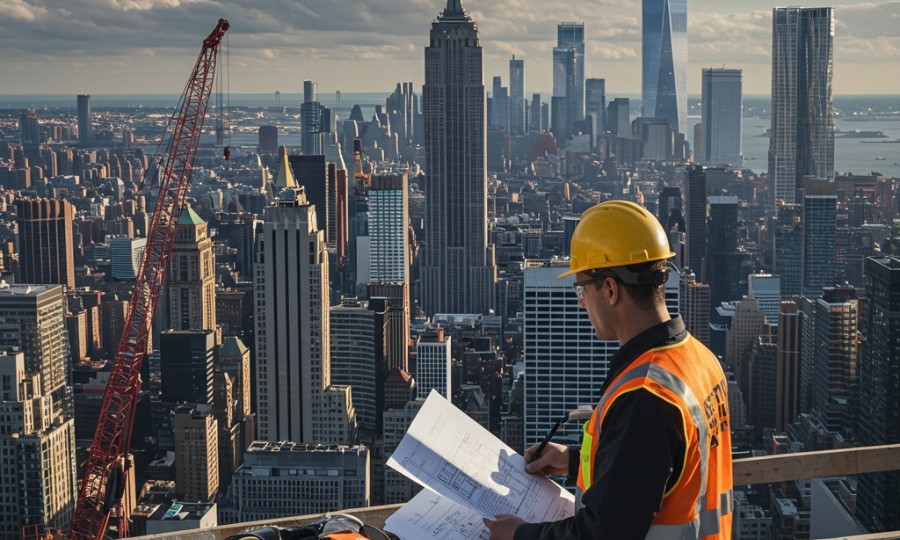
Hello from RMFW Law. As your trusted New York City personal injury lawyers, we always prioritize your safety. Construction sites in our bustling city are dynamic places, yet they absolutely must be safe for every worker and passerby. Consequently, staying informed about the latest safety regulations is crucial for everyone involved. We want to bring your attention to significant updates to the NYC Building Code, set to take effect very soon. These changes aim to enhance safety standards across the five boroughs, fundamentally impacting how construction projects are managed. Ultimately, these new rules mean greater protection for workers and the public alike.
The Evolving Definition of a ‘Major Building’
Effective December 11, 2024, the NYC Building Code will redefine what constitutes a “Major Building.” Previously, this designation typically applied only to the largest, tallest structures. However, the new rules expand this definition significantly. Now, any building that is seven stories or more in height, or measures 75 feet or more from grade to the highest point, will be classified as a “Major Building.” This alteration is not merely semantic; it carries profound implications for construction safety throughout the city. This revised definition means that a much broader range of projects will now fall under stricter safety oversight. Consequently, more construction sites will be subject to rigorous safety protocols, which is excellent news for worker protection and public well-being. Furthermore, this change reflects a deeper commitment to comprehensive safety standards across all relevant projects.
Expanded Site Safety Requirements: A New Era of Oversight
With the expanded “Major Building” definition comes a necessary increase in site safety requirements. Projects now categorized as “Major Buildings” must adhere to significantly more stringent regulations. Firstly, they will require a detailed Site Safety Plan. This comprehensive plan outlines specific safety procedures, crucial emergency protocols, and vital risk mitigation strategies tailored to the unique challenges of each construction site. Moreover, it ensures that potential hazards are identified and addressed before work even begins.
Secondly, these sites must designate a Site Safety Manager or Coordinator. A Site Safety Manager is required for new buildings 10 stories or more, or existing buildings 15 stories or more undergoing alteration or demolition. For other “Major Buildings” that don’t meet these height thresholds but still fall under the new definition, a Site Safety Coordinator will be necessary. These individuals possess specialized training and are responsible for overseeing the implementation of the Site Safety Plan daily. They ensure compliance with all safety regulations, conduct regular inspections, and address potential hazards promptly. Therefore, their presence significantly enhances site safety. Additionally, all workers on these newly defined “Major Building” sites will need additional Site Safety Training (SST). This enhanced training ensures that every individual on such a project understands best practices for working safely and recognizes potential dangers. Ultimately, this comprehensive approach creates a safer work environment for everyone.
New Rules for Construction Superintendents: Increased Accountability
Beyond the “Major Building” redefinition, the NYC Building Code introduces new rules specifically targeting licensed Construction Superintendents. These critical changes become effective on January 1, 2025. Construction Superintendents play a vital role in day-to-day site operations and overall safety. The updated regulations significantly increase the specificity of their duties and inspection requirements. For example, superintendents will now have more clearly defined responsibilities regarding daily safety checks. They must also ensure compliance with approved plans and promptly report any unsafe conditions they observe. Furthermore, they must conduct more frequent and thorough inspections of ongoing work, critical equipment, and safety measures. This increased accountability aims to create a more proactive safety environment on construction sites. By strengthening the role of the Construction Superintendent, the city aims to prevent accidents before they happen. Consequently, this protects workers and the public more effectively. These new rules underscore the city’s commitment to robust safety oversight.
Why These Changes Matter for Worker Safety and Public Well-being
These comprehensive updates to the NYC Building Code are not just bureaucratic adjustments; they represent a significant step forward for worker safety. By redefining “Major Buildings,” the city ensures that more projects receive the highest level of safety oversight. Moreover, requiring detailed site safety plans and dedicated safety personnel means that hazards are identified and addressed proactively. This proactive approach saves lives and prevents serious injuries. The enhanced training for workers, coupled with increased accountability for Construction Superintendents, fosters a strong culture of safety from the top down. Ultimately, these measures are designed to reduce the number of construction accidents, injuries, and fatalities that occur in New York City. They establish a clearer framework for responsibility and empower workers with better knowledge and training. Indeed, these regulations offer a new layer of protection for everyone interacting with construction zones.
Understanding Your Rights After a Construction Accident
Despite these important new regulations, accidents can unfortunately still happen. Even with the strictest safety protocols, unforeseen circumstances or negligence can lead to serious injuries. If you or a loved one are involved in a construction accident in New York City, it is crucial to understand your rights immediately. You may be entitled to significant compensation for medical expenses, lost wages, and pain and suffering. Furthermore, construction accidents often fall under specific laws, like New York’s Labor Law sections 240 and 241, which provide strong protections for injured workers. These laws often hold property owners and general contractors strictly liable for certain types of gravity-related injuries, regardless of individual fault. For instance, if you fall from a height because of inadequate safety equipment, the property owner or general contractor might be held liable. Similarly, if falling debris causes injury due to insufficient overhead protection, the same parties could be responsible. These laws are designed to protect workers who face inherent dangers on construction sites.
How RMFW Law Can Help You
Navigating the legal complexities after a construction accident can be incredibly overwhelming, especially when you are recovering from serious injuries. That is precisely where RMFW Law steps in. We are here to help you understand your options, gather crucial evidence, and tirelessly fight for the justice you deserve. We will investigate the accident thoroughly, determining who is responsible for your injuries. Then, we will build a strong, compelling case on your behalf. Our compassionate team will guide you through every step of the legal process, ensuring your voice is heard loudly and clearly. Moreover, we will protect your rights rigorously throughout the entire process. We understand the physical, emotional, and financial toll an accident can take. Therefore, we strive to make the legal journey as smooth and stress-free as possible for you. You do not have to face this challenge alone; we are here to support you.
Take Confident Next Steps
At RMFW Law, we firmly believe that every worker deserves a safe workplace. The upcoming NYC Building Code changes are a profoundly positive development, promising enhanced safety for construction sites across our vibrant city. We remain committed to holding negligent parties accountable when safety standards are breached, ensuring justice for our clients. If you have been injured in a construction accident, please do not hesitate to reach out to us. We offer free, no-obligation consultations, allowing you to discuss your case without any financial commitment. Furthermore, we work on a contingency fee basis, meaning you pay nothing unless we successfully win your case. Let us be your trusted advocates, helping you on your path to recovery and justice. Your well-being is truly our priority, and we are ready to stand by you.
Free Case Consultation
Injured in an accident? Contact Rosenberg, Minc, Falkoff & Wolff for a free and confidential case review with an experienced NYC personal injury attorney.
This article was drafted with AI assistance. Please verify all claims and information for accuracy. The content is for informational purposes only and does not constitute professional advice.


